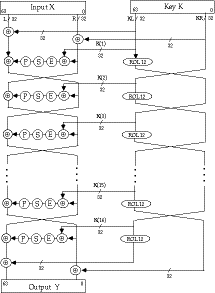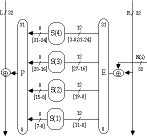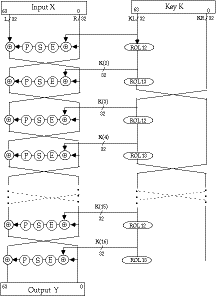LOKI89 and LOKI91
The following are some notes on the LOKI89 and LOKI91 block ciphers,
extracted from the lecture notes for my course in
"
Cryptography and Computer Security".
The LOKI89 Block Cipher
- LOKI is a cipher designed at ADFA as a result of the detailed analysis of
existing block ciphers, particularly of the DES, and is the subject of Dr
Brown's PhD
- several papers have been published since analysing it
- LOKI was intended to be interface compatible with the DES, so it could be
a direct replacement
- hence it uses 64-bit data and a 64-bit key (this being the minimum
resonable, and mostly compatible with DES)
- design criteria were to be published for critique
LOKI89 Design
- overall design is based on design principles developed from a detailed
analysis of the DES, including:
- permutation P and its role in growth of dependence of cipher bits on input
bits
- permutation PC2 and key rotation schedule and its role in growth of
dependence of cipher bits on key bits
- design of the LOKI S-Boxes is based on the non-linearity criteria
developed by Seberry and Pieprzyk, verified against known design criteria for
S-boxes
- aim was for structure to be as simple as possible without compromising
security
- LOKI is a Feistel class cipher, a form of Substitution-Permutation (S-P)
network (Shannon)
- key properties of such S-P networks are:
- the avalanche property
- the completeness property
- provision of these have been achieved by a two phase design
- overall structure assuming S-boxes have these properties
- S-boxes with these properties
LOKI Expansion Function E
- duplicates input + key bits to provide autoclaving
- is based on a regular selection of bits
- is designed to use 32-bit inputs for ease of software implementation
LOKI Permutation P
- sends the output bits from each S-box to the inputs of S-boxes in turn
- can be generated by a difference function on the S-box number of [+3 +2 +1
0 +3 +2 +1 0]
LOKI Key Schedule
- uses a large key rotation removing the need for PC2
- with a rotation value of 12 to match the S-box size
- with 8 rotations of each half, final key is the initial key
- 16 rounds were chosen based on Biham-Shamir results suggesting that less
would be insecure
Overall LOKI89 Structure

LOKI Function f

LOKI Keys
- LOKI Keys are 64-bit blocks, with no parity bits, which may be written in
hex as hhhhhhhhhhhhhhhh16
- Weak, Semi-weak, and Demi-semi-weak keys are those which generate 1, 2 or
4 internal sub-keys only and which should be avoided
- for LOKI all these keys have the form:
hihihihijkjkjkjk16
a total of 216 out of a possible 264
LOKI S-Box Design
- a suitable family of S-boxes with avalanche and completeness properties
were required
- key principle was the concept of boolean functions with maximum
non-linearity, by Pieprzyk and Seberry
- non-linearity of a function f in the set Fn of all
Boolean functions of n variables, is the minimum Hamming distance
between f and the set of all linear Boolean functions Ln
existing in Fn
- further they determined that exponentiation in a Galois field can be used
to form boolean functions with maximum non-linearity
LOKI89 S-Boxes
- LOKI S-boxes were chosen to have 12 inputs and 8 outputs
- to maximise growth of bit dependencies
- as largest values storable in pre-computed tables
- this is partitioned into 16 row functions with 256 columns
- each function is exponentiation in GF(28) as follows:
Sfnr = (c + r) er mod genr
- this field has 30 irreducible polynomials, and 24 exponents (of 13 inverse
pairs) which form functions of maximum non-linearity (of 112)
- a number of other exponents exist which form functions of slightly less
than maximum non-linearity, which may also be suitable for use
- exponent 31 was chosen as the smallest that gives maximum non-linearity
- 16 irreducible polynomials were chosen from the 30 available based on
tests against principles S4 to S7, the results showing little significant
variation between the alternatives.
- the resultant S-functions have non-linearities over all inputs and outputs
of between 1896 and 1936 out of a possible 1984.
- they are combined in the following structure to form the LOKI S_box:

LOKI89 Cryptanalysis
- LOKI89 with up to 10 rounds can be attacked by differential cryptanalysis
using:
A.(00000510,0)->(0,00000510) always
B.(0,00000510)->(00000510,0) Pr(118/2^20)
found independently by Biham, Knudsen
- LOKI89 with up to 14 rounds can also be attacked using a 3 round
characteristic:
A.(00400000,0)->(0,00400000) always
B.(0,00400000)->(00400000,00400000) Pr(28/4096)
C.(00400000,00400000)->(00400000,0) Pr(28/4096)
found independently by Kwan, Knudsen
- LOKI89 key space is 2^60 due to the following relation:
LOKI(P, K)(+)pppppppppppppppp =
LOKI(P(+)pppppppppppppppp,K(+)mmmmmmmnnnnnnnn)
where p=m(+)n, m,n arbitrary hex values
found independently by Biham, Knudsen, and Kwan
The LOKI90 Block Cipher
LOKI91 Design
- used the following additional guidelines:
- analyse key schedule to minimize generation of equivalent key, or related
(key, plaintext) pairs
- minimise probability of f(x')->0 by requiring XOR
differences giving zero output to be due to those bits permuted (by E) to more
than one S-box input
- ensure cipher has sufficient rounds so exhaustive search is the optimal
attack (ie have insufficient pairs for differential cryptanalysis)
- ensure cannot make all S-boxes give zero outputs, increasing security when
for hashing modes.
LOKI91 Specification
- the following changes were made to LOKI89
- 1
- change the key schedule so the halves were swapped after every second round
- 2
- change the key rotation schedule to alternate between ROT12 (odd rounds)
and ROT13 (even rounds)
- 3
- remove the initial and final XORs of key with plaintext and ciphertext
respectively
- 4
- alter S-box function to:
Sfn(r,c)=(c+((r*17)(+)ff16)&ff16)31
mod genr
generator polynomials genr as in LOKI89
Overall LOKI91 Structure

LOKI91 Cryptanalysis
- removal of initial and final XORs necessary due to other changes -
increases ciphertext dependence on key from 3 to 5 rounds, still good compared
to DES (5/7 rounds)
- key schedule changes:
- greatly reduce number of weak (*) & semi-weak keys:
Encrypt Key Decrypt key
0000000000000000 0000000000000000 *
00000000aaaaaaaa aaaaaaaa00000000
0000000055555555 5555555500000000
00000000ffffffff ffffffff00000000
aaaaaaaa00000000 00000000aaaaaaaa
aaaaaaaaaaaaaaaa aaaaaaaaaaaaaaaa *
aaaaaaaa55555555 55555555aaaaaaaa
aaaaaaaaffffffff ffffffffaaaaaaaa
5555555500000000 0000000055555555
55555555aaaaaaaa aaaaaaaa55555555
5555555555555555 5555555555555555 *
55555555ffffffff ffffffff55555555
ffffffff00000000 00000000ffffffff
ffffffffaaaaaaaa aaaaaaaaffffffff
ffffffff55555555 55555555ffffffff
ffffffffffffffff ffffffffffffffff *
- also leave just single bit complementation property:
_________ _ _
LOKI(P,K)= LOKI(P,K)
- the S-box function redesign:
- ensures zero input gives non-zero output
- improves LOKI91 immunity to differential cryptanalysis,can be attacked in
up to
- 10 rounds using a 2 round characteristic
- f(x')->0'with Pr(122/1048576)
- 12 rounds using a 3 round characteristic
- f(x')->x'with Pr(16/4096) (twice)
- insufficient pairs to attack 16 round LOKI91
- require 280 pairs for 3 round char
- require 292 pairs for 2 round char
- but only have 263 possible plaintext pairs
Latest Analysis of LOKI91
- Knudsen presented a paper at Auscrypt'92
- confirmed there are no characteristics with high enough probability to
attack LOKI91 faster than keyspace search
- showed size of image of LOKI f function is F(8,13) x
2 ^(32) significance of this is debateable
- presents chosen plaintext attack reducing exhaustive keyspace search by 4
using 2 ^(32) + 2 chosen plaintexts
- Biham has presented his related key attacks
- only applicable if attacker can force rekey by pattern
- seem to confirm security of LOKI91 at present
- is now susceptible to exhaustive keyspace search, though harder than for
DES (60-64 bits vs 56 for DES)
Dr Lawrie Brown / 30 Apr 99




